![]()
St. Louis Paperweights for
Sale
![]()
St. Louis Paperweights for
Sale
Although the modern production of paperweights started in 1952, the output of millefiori and lampwork paperweights was small. Fewer than 400 lampwork and millefiori paperweights were made between 1952 and 1955. They were not all signed or dated. The most successful product of this early revival period was the Queen Elizabeth sulphide which was made to commemorate her coronation in 1953.
After 1955, no additional weights were made at St. Louis until 1965. In 1965 the factory resumed production of lampwork and millefiori paperweights and then in 1967 they began a series of sulphide weights. Finally, in 1970 they started producing annual limited edition paperweights.
You can read more about the St. Louis Paperweights in the books:
| 4643 | Very Early St. Louis 1954 Cherries on
Latticinio Paperweight. dated 1954. This is one
of only a few very early modern St. Louis lampwork
paperweights. It features an arrangement of six cherries,
leaves, and stems placed on a swirling double latticinio
ground. The paperweight is signed and dated with a "SL 1954"
millefiori cane in the design. The base is
polished concave. This paperweight is one of the earliest of
the modern SL lampwork paperweights and was probably made by Paul
Gossmann with guidance from Louis Lutz. A precious addition to
any collection of Saint Louis paperweights. Note on execution: This very early Saint Louis paperweight was made when Saint Louis was exploring the possibility of resuming paperweight production. It should be considered an experiment and is not perfect. The millefiori in the top are smudged and there are some tiny tool marks in the overlay. Paul Gossmann, an 18 year old glass blower at St. Louis, was assigned to try to duplicate the classic designs of the 19th century. Working with Louis Lutz, a retired glassworker from decades earlier, Gossmann experimented with millefiori and with lampwork in 1951 or 1952 and as quality improved made the first overlay paperweights at the end of 1953. His attention was then redirected to the production of sulphide paperweights and the 1953 Queen Elizabeth sulphide. Cristalleries de Saint Louis was
founded in 1767 in Lorraine, which became part of France in
1766. The region was already home to several
glassworks. Paperweight production started at St. Louis in
1845 and most likely continued until about 1860. Although
the modern production of paperweights started in 1952, the
output of millefiori and lampwork paperweights was small.
Fewer than 400 lampwork and millefiori paperweights were made
between 1952 and 1955. They were not all signed or
dated. The most successful product of this early revival
period was the Queen Elizabeth sulphide which was made to
commemorate her coronation in 1953. After 1955, no
additional weights were made at St. Louis until 1965. In
1965 the factory resumed production of lampwork and millefiori
paperweights and then in 1967 they began a series of sulphide
weights. Finally, in 1970 they started producing annual
limited edition paperweights. Large size: Just over 3 1/16" diameter by just over
1 5/16" high. The base is polished concave. The
paperweight has a relatively flat profile. For extra pictures, click on the picture at the right and the following links: Large picture$395 postage paid in the US. Click on the picture to see a larger image. |
Click on the picture
to see a larger image 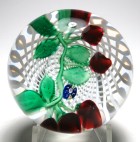 |
| 4575 | St. Louis 1973 Millefiori Looped Garlands
Paperweight - Magnum Limited Edition. dated 1973.
This paperweight features a millefiori garland with six loops
arranged a large complex millefiori cane. The six loops
alternate between white and blue canes. The design is placed
on an opaque red ground. It is signed and dated with a "SL
1973" complex millefiori cane between two of the loops. It
also has its original (slightly worn) "CRISTAL SAINT LOUIS FRANCE"
foil label. A precious addition to any collection of Saint
Louis paperweights. According to the two books on St. Louis paperweights, this paperweight was issued in a limited edition of 400 paperweights of which 250 were reserved for US collectors. Note on condition: This paperweight has a small scuff mark (about 3/16" long) on the side near the base. Otherwise, it is in excellent condition with no other damage found. Cristalleries de Saint Louis was
founded in 1767 in Lorraine, which became part of France in
1766. The region was already home to several
glassworks. Paperweight production started at St. Louis in
1845 and most likely continued until about 1860. Although
the modern production of paperweights started in 1952, the
output of millefiori and lampwork paperweights was small.
Fewer than 400 lampwork and millefiori paperweights were made
between 1952 and 1955. They were not all signed or
dated. The most successful product of this early revival
period was the Queen Elizabeth sulphide which was made to
commemorate her coronation in 1953. After 1955, no
additional weights were made at St. Louis until 1965. In
1965 the factory resumed production of lampwork and millefiori
paperweights and then in 1967 they began a series of sulphide
weights. Finally, in 1970 they started producing annual
limited edition paperweights. Very large size: 3 1/4" diameter by 2 1/4"
high. The base is ground concave. For extra pictures, click on the picture at the right and the following links: Large picture$395 postage paid in the US. Click on the picture to see a larger image. |
Click
on the picture to see a larger image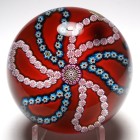 |
| 2999 | Very Early St. Louis 1953 Millefiori
Mushroom Double Overlay Paperweight. dated 1953.
This is one of only a few very early modern St. Louis millefiori
mushroom paperweights. It has a closepacked millefiori design
pulled down to the base to form a mushroom shape. It is signed
and dated with a "SL 1953" millefiori cane in the design. It
has a double overlay of dark blue over light blue and is finished
with a large top facet and five side facets. The base is
ground slightly concave and has a star cutting. This
paperweight is one of the earliest of the modern SL millefiori
mushroom paperweights and was probably made by Paul Gossmann with
guidance from Louis Lutz. A precious addition to any
collection of Saint Louis paperweights. Note on execution: This very early Saint Louis paperweight was made when Saint Louis was exploring the possibility of resuming paperweight production. It should be considered an experiment and is not perfect. The millefiori in the top are smudged and there are some tiny tool marks in the overlay. Paul Gossmann, an 18 year old glass blower at St. Louis, was assigned to try to duplicate the classic designs of the 19th century. Working with Louis Lutz, a retired glassworker from decades earlier, Gossmann experimented with millefiori and with lampwork in 1951 or 1952 and as quality improved made the first overlay paperweights at the end of 1953. His attention was then redirected to the production of sulphide paperweights and the 1953 Queen Elizabeth sulphide. Cristalleries de Saint Louis was
founded in 1767 in Lorraine, which became part of France in
1766. The region was already home to several
glassworks. Paperweight production started at St. Louis in
1845 and most likely continued until about 1860. Although
the modern production of paperweights started in 1952, the
output of millefiori and lampwork paperweights was small.
Fewer than 400 lampwork and millefiori paperweights were made
between 1952 and 1955. They were not all signed or
dated. The most successful product of this early revival
period was the Queen Elizabeth sulphide which was made to
commemorate her coronation in 1953. After 1955, no
additional weights were made at St. Louis until 1965. In
1965 the factory resumed production of lampwork and millefiori
paperweights and then in 1967 they began a series of sulphide
weights. Finally, in 1970 they started producing annual
limited edition paperweights. Large size: 3" diameter by just over 2 3/8"
high. The base is ground slightly concave and has a star
cutting. The paperweight is faceted with one large top facet
and a five side facets. For extra pictures, click on the picture at the right and the following links: Large pictureSOLD. Click on the picture to see a larger image. |
Click
on the picture to see a larger image |
| 3661 | Set of St. Louis Paperweight Style Letter
Seals Limited Edition. dated 1974. This is pair
of St. Louis paperweight style letter seals, one red with a white
stripe and one blue with a white stripe. The bases are flat
and blank, ready to be engraved to create your own custom letter
seals. Each handle is hollow blown with white pinstripe
twists. These letter seals were issued in 1974 in limited
editions of 500 of each color and were sold individually and in
boxed sets. Each seal is signed on the top of the base with an
etched signature "1974 S. LOUIS France". A great addition to
any collection of modern French paperweights. Cristalleries de Saint Louis was
founded in 1767 in Lorraine, which became part of France in
1766. The region was already home to several
glassworks. Paperweight production started at St. Louis in
1845 and most likely continued until about 1860. Although
the modern production of paperweights started in 1952, the
output of millefiori and lampwork paperweights was small.
Fewer than 400 lampwork and millefiori paperweights were made
between 1952 and 1955. They were not all signed or
dated. The most successful product of this early revival
period was the Queen Elizabeth sulphide which was made to
commemorate her coronation in 1953. After 1955, no
additional weights were made at St. Louis until 1965. In
1965 the factory resumed production of lampwork and millefiori
paperweights and then in 1967 they began a series of sulphide
weights. Finally, in 1970 they started producing annual
limited edition paperweights. Size: These are handmade and differ very slightly
in size. The blue seal is 4 1/4" tall, the red seal is
slightly less. The base of each is just over 1 1/2"
diameter. The base of each seal is polished flat. For extra pictures, click on the picture at the right and the following links: Large pictureSOLD. Click on the picture to see a larger image. |
Click
on the picture to see a larger image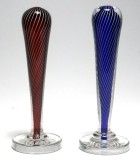 |
| 5966 | Large St. Louis 1986 Spray of Red and
White Lilies of the Valley Paperweight on Turquoise Ground -
Limited Edition with Certificates and Box. dated
1986. This paperweight features a wonderful spray of eleven
red and white lilies of the valley with green leaves and
stems. The flowers are also called bell flowers. The
design is set on an opaque turquoise ground. It is signed in
the center of the base with a St. Louis "SL 1986" complex signature
/ date cane. It comes with two certificates, one from St.
Louis and one from Paul Jokelson. Both identify this as
edition number 31 in a limited edition of 250 paperweights. It
also has its original (worn) blue padded St. Louis box. The
paperweight is finished with a large top facet and six side
facets. An especially nice paperweight with great color and
execution. Cristalleries de Saint Louis was founded in 1767 in Lorraine, which became part of France in 1766. The region was already home to several glassworks. Paperweight production started at St. Louis in 1845 and most likely continued until about 1860. Although the modern production of paperweights started in 1952, the output of millefiori and lampwork paperweights was small. Fewer than 400 lampwork and millefiori paperweights were made between 1952 and 1955. They were not all signed or dated. The most successful product of this early revival period was the Queen Elizabeth sulphide which was made to commemorate her coronation in 1953. After 1955, no additional weights were made at St. Louis until 1965. In 1965 the factory resumed production of lampwork and millefiori paperweights and then in 1967 they began a series of sulphide weights. Finally, in 1970 they started producing annual limited edition paperweights. In addition to the three types already mentioned, millefiori, lampwork, and sulphide paperweights, St. Louis also made a small number of designs with gold inclusions. Large size : 3 1/16" diameter by just under 1 13/16"
high. The bottom is ground concave. The paperweight is
finished with a large top facet and six side facets. For extra pictures, click on the picture at the right and the following links: Large pictureSOLD. Click on the picture to see a larger image. |
Click
on the picture to see a larger image 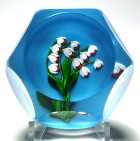 |
| 5965 | St. Louis 1977 Limited
Edition Five Flower Bouquet Paperweight with Red and White Double
Overlay. dated 1977. This 1977 St. Louis
paperweight features a lampwork bouquet of five red, white, and blue
clematis flowers with green stems and leaves. The design is
placed on a clear ground and encased in a brilliant red and white
double overlay. It is finished with a large top facet and
twelve side facets in two rows, plus a star cut base. The
paperweight is is signed in the center of white flower with a
complex "SL 1977" signature / date cane, although the signature cane
is put in upside down. This limited edition design was offered
by St. Louis in a limited edition of 450 paperweights of which 200
were reserved for the American market. It also has its
original foil label "CRISTAL SAINT LOUIS FRANCE" and comes with its
original certificate of authenticity assigning this as edition
number 269 of the 1150 limited edition paperweights made for the
American market in 1977. It also comes with its original very
worn and stained box. See note below about manufacturing
flaws. A brilliant design. A great addition to any
collection of modern French paperweights. Note about manufacturing flaws: The double overlay has several manufacturing flaws which are shown in the pictures. The most significant is a line on the side where there is a lighter red color. There are also two tiny tool marks, one near the top facet and another near the base. The latter may be a tiny nick or scratch and there is also a nearby scratch on the clear base. All of these marks and scratches are very small but showed up in the pictures. Cristalleries de Saint Louis was
founded in 1767 in Lorraine, which became part of France in
1766. The region was already home to several
glassworks. Paperweight production started at St. Louis in
1845 and most likely continued until about 1860. Although
the modern production of paperweights started in 1952, the
output of millefiori and lampwork paperweights was small.
Fewer than 400 lampwork and millefiori paperweights were made
between 1952 and 1955. They were not all signed or
dated. The most successful product of this early revival
period was the Queen Elizabeth sulphide which was made to
commemorate her coronation in 1953. After 1955, no
additional weights were made at St. Louis until 1965. In
1965 the factory resumed production of lampwork and millefiori
paperweights and then in 1967 they began a series of sulphide
weights. Finally, in 1970 they started producing annual
limited edition paperweights. Large Size: 3 1/8" diameter by 2 1/4" high.
The base has a star cut. Finished with a red and white
double overlay and faceted with a large top facet and twelve side
facets. For extra pictures, click on the picture at the right and the following links: Large pictureSOLD. Click on the picture to see a larger image. |
Click
on the picture to see a larger image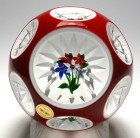 |
| 5624 | Magnum St. Louis 1970 Faceted Red Double
Clematis Paperweight. dated 1970. This
paperweight features a wonderful red double clematis with twelve red
petals in two layers, an emerging bud, green sepals, leaves
and stems. There is a complex yellow St. Louis "SL 1970"
signature / date cane in the center of the clematis. The
signature cane is rotated in its placement (almost upside
down). The design is placed over a opaque dark blue (almost
black) ground. The paperweight is faceted with one large top
facet and six side facets. St. Louis started producing annual
limited editions in 1970. This paperweight, the double
clematis, was issued in a limited edition of 800 paperweights, 300
of which were reserved for the American market. Of those
reserved for American collectors, 150 were red and 150 were
pistachio colored. A wonderful paperweight.
St. Louis started producing annual limited editions in 1970. Only three designs were produced in 1970, this faceted double clematis, a large unfaceted dahlia, and a millefiori double overlay mushroom. These paperweights appear in the the two books on St. Louis paperweights, The Art of the Paperweight - Saint Louis (First Edition (1981) and Second Edition (1995) by Gerard Ingold. Cristalleries de Saint Louis was founded in 1767 in Lorraine, which became part of France in 1766. The region was already home to several glassworks. Paperweight production started at St. Louis in 1845 and most likely continued until about 1860. Although the modern production of paperweights started in 1952, the output of millefiori and lampwork paperweights was small. Fewer than 400 lampwork and millefiori paperweights were made between 1952 and 1955. They were not all signed or dated. The most successful product of this early revival period was the Queen Elizabeth sulphide which was made to commemorate her coronation in 1953. After 1955, no additional weights were made at St. Louis until 1965. In 1965 the factory resumed production of lampwork and millefiori paperweights and then in 1967 they began a series of sulphide weights. Finally, in 1970 they started producing annual limited edition paperweights. In addition to the three types already mentioned, millefiori, lampwork, and sulphide paperweights, St. Louis also made a small number of designs with gold inclusions. Very Large Size : 3 1/4" diameter by 2" high.
The bottom is ground concave. It is faceted with one large
top facet and six side facets. For extra pictures, click on the picture at the right and the following links: Large pictureSOLD. Click on the picture to see a larger image. |
Click
on the picture to see a larger image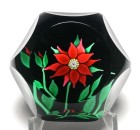 |
| 5995 | Modern St. Louis Cupid Amour Sulphide
Paperweight. dated 1979. This is a
modern St. Louis sulphide paperweight featuring a ceramic image of
cupid set on a opaque red ground and surrounded by a garland of blue
lampwork flowers with millefiori centers and green leaves.
There is an opaque white layer under the red layer which is visible
from the base. The paperweight was issued in a limited edition
of 400 in 1979. It is faceted with a large top facet and six
side facets. It is signed on the base with a millefiori
signature date cane "SL 1979". A great paperweight with
fantastic color. The conceptual design for the paperweight was by Linda Pope-Selman. Gilbert Poillerat sculpted the model for the image of cupid. The sulphide bears the title AMOUR and the initials of the sculptor (GP). Sulphides are cast objects (animals,
flowers, people) made of a ceramic material that has properties
similar to the surrounding glass. They are normally white,
but are also sometimes colored or even painted. The
objects are cast in a mold that copied or made directly from a
medallion, coin or sculpture. The finest French sulphides
are cast in a mold made by a skilled artist. Often a
sulphide will have a silvery appearance due to a thin layer of
trapped bubbles between the glass and the sulphide itself. Cristalleries de Saint Louis was founded in 1767 in Lorraine, which became part of France in 1766. The region was already home to several glassworks. Paperweight production started at St. Louis in 1845 and most likely continued until about 1860. Although the modern production of paperweights started in 1952, the output of millefiori and lampwork paperweights was small. Fewer than 400 lampwork and millefiori paperweights were made between 1952 and 1955. They were not all signed or dated. The most successful product of this early revival period was the Queen Elizabeth sulphide which was made to commemorate her coronation in 1953. After 1955, no additional weights were made at St. Louis until 1965. In 1965 the factory resumed production of lampwork and millefiori paperweights and then in 1967 they began a series of sulphide weights. Finally, in 1970 they started producing annual limited edition paperweights. Gilbert Poillerat (1902 - 1988) was
a French designer, jeweler, and sculptor. He studied at
the École Boulle, graduating in 1921. Initially he worked
in wrought iron for Edgar Brandt doing design and production
work. Later Poillerat branched out to design furniture and
other decorative arts. In 1946 he became a professor at
the École Nationale des Arts Decoratifs. He taught there
for 26 years, all the while continuing his own design output,
collaborating with the likes of André Arbus, Jean Pascaud, and
Vadim Androusov. During the 1950s, Poillerat became
involved in the rediscovery of the art of sulphide paperweights
at Baccarat and St. Louis, contributing to many of the early
modern sulphide paperweights. Large size: Just under 3 1/8" diameter by just under
1 5/8" high. The bottom is ground concave. For extra pictures, click on the picture at the right and the following links: Large picture$295 postage paid in the US. Click on the picture to see a larger image. |
Click
on the picture to see a larger image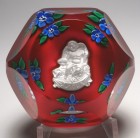
|
Revised 9/16/2025 EI9